Editor’s Introduction: This month’s “Sequential Erudition” features Ariel Kahn’s paper originally presented at the IBBY UK/NCRCL Conference last November. We choose it for this month’s column because its use of Laura Mulvey’s concept of the “gaze” fits with Noah’s recent post on Moto Hagio here at HU and a number of comment conversations. Personally, I appreciate the way Kahn combines thematic and formal analysis in combination with theoretical texts to make his point and provide an engaging essay. We’ll still looking for more papers for future columns, so if any academics out there would like to participate, leave a message. -Derik.
Reading Between the Lines: The Subversion of Authority in Two Graphic Novels for Young Adults by Ariel Kahn
Originally presented at IBBY UK/NCRCL Conference, 14 November 2009 at Roehampton University, London.
A recent resurgence in the publication of comics and graphic narratives specifically aimed at young adults raises a range of issues about the nature of authority, and the role of the reader in negotiating the narrative and constructing meaning in and through the interplay of image and text. This paper explores the diverse relationships between image and text, and the implications of the enhanced role they create for the reader.
The Problematics of Children’s Literature
The notions of authority and of the relationship between writer and reader are central to critical discussions of literature for children and young adults. This is evident in the contrasting positions taken by Jacqueline Rose (1984) and Peter Hollindale (1997). Rose argues that ‘children’s fiction is impossible … it hangs on an impossibility, … this is the impossible relationship between adult and child’ (1984: 1). The use of the author’s adult authority to shape and instruct the reader leads Rose to view children’s literature pessimistically as an act of repression. In contrast, in Signs of Childness in Children’s Books, Hollindale defines the divide in critical focus in children’s literature as existing between those who ‘prioritise either the children or the literature’ in the study of children’s literature (1997: 8). He advocates instead a study of children’s literature as a ‘reading event’ (p.30) in a strategy that allows both the child and the text to have a place.
Image/Text Relationships in Picture Books and Comics
The possibility of such a ‘strategy’, and the exploration of the narrative possibilities of such a ‘reading event’ are, I will argue, particularly striking in comic books written for young adults, picture books in which the active engagement with image and text opens up a multiplicity of possible readings, rather than enacting the closure and repression of which Rose warns. In How Picturebooks Work (2001) Maria Nikolajeva and Carole Scott identify ‘a taxonomy of picture book interactions’, which places the interactions of image and text on a sliding scale from Symmetry, to Enhancement, Counterpoint, and Contradiction. The authors are most interested in those picture books that use ‘counterpoint’, i.e., when ‘words and images provide alternative information or contradict each other in some way’ (Nikolajeva and Scott, 2001: 17, quoted in Donovan, 2002: 110).
The possibility of such a ‘contradiction’ in comics, unsettling the hierarchy between reader and writer, is a key element of comics’ storytelling. ‘The art of comics is as subtractive an art as it is additive’, Scott McCloud writes. ‘And finding the balance between too much and too little is crucial’ (1994: 85). Figuring out exactly how many panels are needed to tell a story, as well as how to arrange them, is not a simple matter. Allowing an audience to make their own assumptions about what happens in the ‘gutter’ (the space between frames) can make the story more engaging, but ‘as closure between panels becomes more intense, reader interpretation becomes far more elastic. And managing it becomes more complicated for the creator’ (p.86). It is this very elasticity, and the way skilful writers and artists allow the reader to shape the narrative, that will be the focus of my discussion.
Rose’s argument about power and authority have particular resonance in texts written for young adults. R.R. Johnston (2006) asks: To what extent do we need to protect the adolescent reader, and is it then possible to extend the adolescent reader? He describes young adult fiction as a genre that creates a ‘thinking space’ for the adolescent reader. This thinking space expands in comics to include the space around the panels, McCloud’s ‘gutter’, and the spaces between text and image. This widening space for interpretation also complicates the reader’s relationship with the protagonists, and renders simple identification difficult. John Stephens argues that it is a common characteristic of young adult fiction to have adolescent protagonists with whom the adolescent reader is expected to identify. Stephens argues that authors of novels that locate the reader within the narrative assume that the reader’s subjectivity is lost as part of the reading process (1992: 4). This practice discourages the adolescent reader from questioning the novel and potentially hinders their development as readers.
Character, Genre and Identification
In Salem Brownstone: All Along the Watchtowers (2009) by John Harris Dunning and Nikhil Singh, published by Walker specifically for young adults, the nature of reader identification and interpretation focus on the relationship between gender and the gaze. Given that this is a noir narrative (a term originally relating to film noir), it may be useful to consider applying a critical framework from Laura Mulvey’s celebrated essay Visual Pleasure and Narrative Cinema (1975). Mulvey argues that ‘there are three different looks associated with cinema: that of the camera as it records the pro-filmic event, that of the audience as it watches the final product, and that of the characters at each other within the screen illusion’. If we apply this to comics, rather than the author/reader dichotomy, we now have the gazes/readings of the writer, the artist, the characters and the readers. For Mulvey, the issue of gender resides at the heart of viewing, and by implication for our discussion, of reading.
In a world ordered by sexual imbalance, pleasure in looking has been split between active/male and passive/female. The determining male gaze projects its phantasy on to the female form which is styled accordingly. In their traditional exhibitionist role women are simultaneously looked at and displayed, with their appearance coded for strong visual and erotic impact so that they can be said to connote to-be-looked-at-ness. (1975, n.p.)
Mulvey’s notion of visual signifiers and female identity is a particular feature of noir texts. J.A. Place (1978) examines the visual motifs through which two opposing archetypal women – the spider woman and the nurturing woman – are articulated in such texts. Writing about the spider woman, Place comments that ‘the sexual woman’s dangerous power is expressed visually’ and details her iconography: long hair, cigarette smoke as a cue for immorality, a habitat of darkness and, perhaps most importantly, a domination of composition, camera movement and lighting which seems to pull ‘the camera (and the hero’s gaze with our own) irresistibly with them as they move’ (Place, 1978: 45). Despite her apparent power, the femme fatale ‘ultimately loses physical strength’ and is actually or symbolically imprisoned (p.45).
In our first meeting with Cassandra, a key female figure in Salem, we witness a character who bears all the hallmarks of a spider woman, including her pose. We also witness the exchange of gazes between Cassandra and the eponymous male protagonist, Salem (Figure 1).
Figure 1. Meeting Cassandra. From Salem Brownstone.
In keeping with Place’s paradigm, Cassandra appears imprisoned, and in the following page leaps from the window into the imprisoning embrace of a thornbush. Yet this is presented as protection from death, and a kind of liberation, rather than the punishment traditionally associated with her role; the thorns are described as ‘a thousand stinging whipcord saviours’. Dunning and Singh further subvert the iconography associated with her role by allowing her to transform into her apparent binary opposite, the nurturing woman, as she cares for the injured Salem. This challenging of reductive gender binaries deepens as the narrative develops. In a crucial scene, Salem disappears into the ‘fleshy gateway’ of his familiar, and is feminised, whilst Cassandra stays behind to take on his adversary.
The protagonists are essentially transgendered here, a pattern that continues when Salem returns (Figure 2). Strikingly, the image of Cassandra also becomes a visual ‘text’ as her clothing bears constantly changing messages that comment ironically on her status within the narrative; the reader is forced to confront the sense in which her characters function as text, precisely at the moment when her character subverts both iconic noir femininity (she still embodies the spider woman, with her long hair and cigarette) and complicates the reader’s interpretive role with image and text, not simply forming a ‘counterpoint’, but actually merging; image becomes text. The hierarchy between male protagonist and female is also destabilised, with the hero squeezed to the ‘weaker’ left margin of the frame, and the apparently secondary Cassandra dominating the composition.
Figure 2. Transgendering noir roles. From Salem Brownstone.
Feminising the Gaze
This movement towards subverting reader expectation and problematising reader identification is even more strongly apparent in the depiction of another strong, complex female character in Salem, the mysterious Lola Q. In Figure 3 we witness her gazing protectively at Salem, on whom she is spying, and then become gradually aware of our own voyeurism as she stares back at us through the window of her room, this frame within a frame drawing attention to our intrusive gaze; she turns a ‘blind eye’ to us and we focus in the unreadable blank of her eyepatch, and the emotional and psychological damage it signifies.
Figure 3. Lola Q and the female gaze. From Salem Brownstone.
Lola is another wounded and complex female figure who incarnates both the spider woman and the nurturing woman; in a climactic scene, she ruptures the eye of Salem’s foe, and asserts her own authority over the narrative. In Figure 4, Lola blurs the boundaries between internal and external space, between voyeur and protagonist, as she becomes actively involved in the scene she is watching, and intervenes to devastating effect, without leaving the confines of her room. She assists the hero in completing his mission. In the final panel, she calls through the ‘fleshy gateway’ into which he escaped; again, image and text are fused, as she opens the way for Salem and the reader to arrive at a more complex, nuanced notion of both their own active roles in negotiating the narrative and the possibilities of gender roles within and without the text in a potentially liberating act of subversion.
Figure 4. Lola Q takes aim. From Salem Brownstone.
Skimming below the Surface: The Politics of Reading
The second text I wish to explore is also published by Walker as part of the same series: Skim (2009) by Mariko Tamaki and illustrated by Jillian Tamaki. Once again, gender and the subversion of authority are aligned; here the teenaged protagonist, Skim, has formed a romantic obsession with her English teacher, Ms Archer.
The first panel on page 13, Skim’s objectification of her teacher by cutting off the teacher’s head, suggests that Skim is interested only in her body (Figure 5).
Figure 5. Gaze and subjectivity in Skim.
In the final panel of the same page, while turning elusively away from Skim, Ms Archer comments directly on Skim’s gaze, claiming that Skim herself has ‘the eyes of a fortune teller’, a motif that recurs many pages later when the teacher attends a Halloween party dressed as a fortune teller (Figure 6).
Figure 6. Subversion of authority in Skim.
This suggests that Ms Archer has actively absorbed and become the conscious embodiment of Skim’s gaze, and prefigures their romantic entanglement. This double-page spread has the image of the teacher in a window-like panel inset on the left-hand page, as she pauses with her hand on the door, a liminal space that will become significant as the narrative develops. Skim and her best friend, Lisa, flee the viewer in an image of childlike abandon, while Skim’s narration suggests that she is concealing the truth of her encounter with her teacher from Lisa and from us: ‘Technically what I said is not a lie. Technically nothing happened.’ Skim then quotes a Wicca (a form of witchcraft) textbook that has inspired her, but she uses it intertextually as an indirect ‘reading’ of her own erotic experience with Ms Archer, depicted on the following double-page spread. This awareness of the protagonist as a subjective reader foregrounds the process of reading and identification, and again complicates the reader’s identification with Skim. The subversion of textual authority takes on a particular resonance given that Ms Archer is a teacher of literature. The following double-page spread depicts the two kissing, in a ‘wild’, natural environment. The reader/viewer peers at them through the trees, foregrounding our own voyeurism, and making us aware of the multiple gazes to which Mulvey referred: the gaze of the character moving interpretively between text and experience in a way that prefigures the reader’s own. In the artistry of the counterpoint between image and text, we are made aware of the similarly interpretive gazes of writer and illustrator. The image of the kiss (Figure 7) subverts the authority of the text on the previous page that ‘nothing happened’, whilst allowing us to return to Skim’s ‘reading’ of her Wiccan passage with renewed comprehension. Just as the linear progression of the reading is interrupted, so is any definitive ‘reading’ of this encounter.
Figure 7. Image as embodied subtext. From Skim.
This active deconstruction of a stable textual meaning recalls one of Derrida’s key terms for the impossibility of signifying meaning textually: ‘erasure’. To highlight notions linked to ‘the metaphysics of presence’, Derrida put them under ‘erasure’, metaphorically pointing out the absence of any definitive meaning (1966: 292–93). This notion takes on particular significance for our understanding of the subversion of the hierarchies of meaning in Skim, as it is featured as a central strategy in the narrative. From the outset, the text presents us with words that Skim both utters and crosses out, allowing the play of presence and absence to call up interpretive strategies on the part of the reader as we acknowledge the simultaneous presence of opposite meanings, presented by text and erasure. In an indicative example (Figure 8), the text is part of the image, as Skim writes and erases in the snow, so we are aware of the subjective experience of rejection by Ms Archer, ‘I hate you’, that lies beneath her apparently universal statement ‘I hate everything’. The page also includes another window-like panel, again reflecting Skim’s gaze, this time at the poster of a boy at the school who committed suicide after rumours of his homosexuality surfaced. This creates a complex task for the reader, as we negotiate between text as image, and image as text; in this instance, we re-enact Skim’s gaze at the poster and the values it embodies, which are presented visually as constricted and narrow, with the more expansive outdoor scenes in which she explores her own attitude to signification.
Figure 8. Text as image, image as text. From Skim
Resisting Closure
The ending of Skim subverts our expectations; there are no moral or ethical consequences to Skim’s affair with her teacher. She moves on, and falls in love with the bereaved ex-girlfriend of the boy whose image we see in Figure 8, a fact which adds another layer to our ‘reading’ of the image–text relationship on that page. In the book’s final image, she approaches her new love silently through the woods, recalling her earlier encounter with the teacher. This time, her partner is hidden from view; only the back of her head is visible, as she resists the reader’s gaze. The boldness of this ending recalls that of Maurice Sendak’s Where the Wild Things Are (1963), where Max returns from the wild imaginative spaces of the image to the confines of his room and the resumption of parental/textual authority. Here, the image is unadorned with text. Skim moves both towards and away from us in distinct images that reveal a complex emotional interplay, with no controlling or defining authority deciding what they mean. The novel ends in wildness, leaving us to negotiate a thicket of possible meanings, and expanding our sense of the possibilities of narrative, characterisation, and creating a ‘reading event’ that empowers us while shrugging off any notion of enforced authority (Figure 9).
Figure 9. A liberating journey into wilderness. From Skim.
Acknowledgements
Illustrations reproduced from Salem Brownstone: All Along the Watchtowers by John Harris Dunning and Nikhil Singh. Copyright © 2009 John Dunning and Nikhil Singh.
Illustrations reproduced from Skim by Mariko Tamaki and illustrated by Jillian Tamaki. Illustrations © 2008 Jillian Tamaki.
Works Cited
Primary Texts
Dunning, John Harris (illus. Nikhil Singh) (2009) Salem Brownstone: All Along the Watchtowers. London: Walker.
Tamaki, Mariko (illus. Jillian Tamaki) (2009) Skim. London: Walker.
Secondary Texts
Derrida, Jaques (1966) Structure, sign and play. In Writing and Difference. London: Routledge (pp.292–93).
Donovan, Ellen Butler (2002) ‘How Picturebooks Work’ (review). Children’s Literature Association Quarterly, vol. 27, no. 2 (pp.110–12).
Hollindale, Peter (1997) Signs of Childness in Children’s Books. Stroud: Thimble Press.
Johnston, R.R. (2006) The Particular Qualities of Novels Addressed to Adolescent Readers. Sydney: University of Technology (unpublished).
McCloud, Scott. Understanding Comics. New York: HarperPerennial, 1994.
Mulvey, Laura (1975) Visual pleasure and narrative cinema. Screen, vol. 16, no. 3 (pp.6–18).
Nikolajeva, Maria and Carole Scott (2001) How Picturebooks Work. New York: Garland Publishing.
Place, J.A. (1978) Women in film noir. In E. Ann Kaplan (ed.) Women in Film Noir. London: British Film Institute.
Rose, Jacqueline (1984) The Case of Peter Pan: Or the Impossibility of Children’s Fiction (New Cultural Studies). London: Macmillan.
Sendak, Maurice (1963) Where the Wild Things Are. New York: Harper & Row.
Stephens, J. (1992) Language and Ideology in Children’s Fiction. London: Longman.
Ariel Kahn is a Senior Lecturer in Creative Writing at Roehampton University (London, UK), where he teaches scriptwriting for comics at BA level and explores comics for Young Adults as part of the MA programme. He also lectures in Film Theory at MET Film School, EalingStudios. He is a contributor to The Jewish Graphic Novel (Rutgers, 2009) edited by Samantha Baskind and Ranen Omer-Sherman.

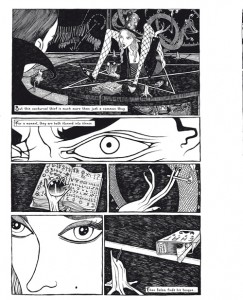
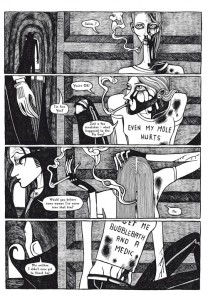
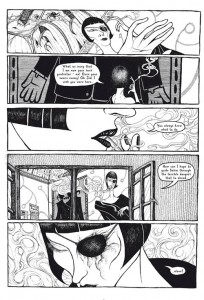
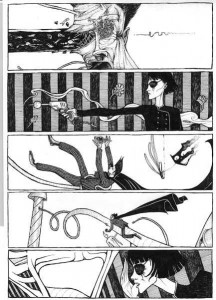
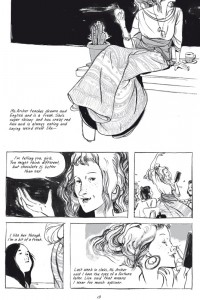
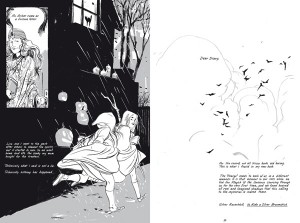
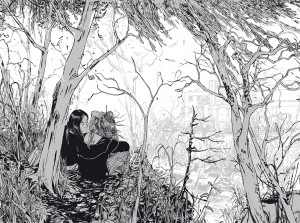
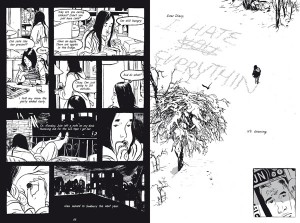

Hi Ariel. Thanks so much for posting this here.
If I understand you aright, you’re working with a contrast between forced identification as restrictive, and more ambiguous identification as subversive or liberating. So less stable textual meanings, and less stable gender identifications are seen as allowing the child readers more interpretive responsibility/freedom/power.
I wonder how this might or might not fit in with Laura Mulvey’s follow up essay (“Afterthoughts on Visual Pleasure and Narrative Cinema) in which she looks (as it were) at ambivalent looking in melodrama’s with female protagonists. (A copy of the essay is here.) Basically, she argues that women have an unstable relation to identification, where they identify with active male protagonists and passive femininity at the same time, creating an indeterminable oscillation. Mulvey doesn’t exactly talk about liberation or subversion in those terms, but she certainly doesn’t seem to exactly thing that ambivalence, at least in the films she looks at, is necessarily or absolutely positive.
So for example, the last page of Skim, with the protagonist coming and going in the wilderness — Mulvey in the later essay might see that as an expression of the way narrative leaves women without a solid identity or foundation (“a phantasy of masculination at cross-purposes with itself, restless in its transvestite clothes.”)
I guess the question in terms of Mulvey is, she seems as far as I can tell to believe that film narrative in itself is phallocentric. Do you think that comics narrative is different in this sense than film narrative because image and text work against each other in comics narrative in a way they don’t in film narrative? Or is Mulvey wrong about film as well?
Pingback: Tweets that mention Reading Between the Lines: The Subversion of Authority in Two Graphic Novels for Young Adults by Ariel Kahn « The Hooded Utilitarian -- Topsy.com
Thanks for your comments Noah.
Both of the comics I explore have strong female protagonists – in Skim, men are noticeably absent. The final image of Skim is tender and unthreatening – it anchors both reader and character by reminding us of Skim’s romantic tryst with her teacher in the same setting. Jillian Tamaki tweeted (Thanks Jillian) that she sees the relationship between the two girls, and the narrative, as a celebration of female friendship; my own interpretation differs, I hope without imposing on or straining the text – which is precisely a mark of the interpretive freedom from a position of security which is the position of both Skim as character and the reader.
In both books, the absence of gendered hierarchies chimes with the particular textual dynamics the writers and artists have set up for the reader. I don’t believe that they invite the kind of unequal, gendred looking that Mulvey posits. I drew on Mulvey’s initial statement of her position partly because she focuses on Noir tropes that Salem subverts, but also because I think comics have huge potential for empowering readers to acknowledge their frames of reference, and their constructedness, in a medium where we actively participate in the construction of the narrative – we can never “disappear into looking” as in some films.
I would be wary of any sweeping theoretical statements about comics versus film – I will say that when I interviewed Rutu Modan last year, she emphasised that she created Numi, her own female protagonist in Exit Wounds, precisely to represent a more real and nuanced feminity, and Numi struggles actively with Koby, the male protagonists’ intitially stereotypical perceptions of her. Modan forces her characters, and her readers, away from simplistic choices and identifications, a feature of both film and comics at their best.
Teaching Children’s literature on the MA at Roehampton, what has often struck me is the stark contrast in books written for Young Adults, between the rigid depiction of Young Adult characters in the narratives, and the intended readership, whose sense of identity is often being profoundly in question, and in a state of flux. Both Skim and Salem have a powerful, joyous and moving sense of artistic integrity, without seeking to impose a viewpoint on the reader. Reading them is exhilirating and delightful, destabilising of certainties in the best way, replacing our given certainties and gender prejudices with exciting new possible forms.
Hey Ariel-
>>>The final image of Skim is tender and unthreatening>>>
I completely disagree with this interpretation of the final page- was surprised when I came across it in your essay, in fact. To me it seems as though the entire forest is a dark, malevolent force that will swallow her, wipe out her identity, that the events of the book have led her to a kind of self-annihilation. Notice the low angle, the lack of face and the small figure surrounded by the tangled, dark, slacking trees and bramble. This is not the airy, define, gently bending forest depicted in the earlier kissing scene- this is the void.
At least, that was my impression :)
Thanks for the essay!
Pingback: Links Round-Up: Engaging Teens, Evaluating Programmes and Free Text « YA Library UK
Hi Sean,
I loved your reading of the final page, and went back to study it again. I think the fact that skim herself is depicted contained within small, defined panels, suro of purpose and her goal, rather than lost in the woods as she might have been, and that the dark threatening wood is not full bleed, but has a white foreground from which we and she observe her friend/love – who is also depicted as a luminous point of reference within the darkness, just as the emotion she represents for Skim is a fixed point within the darkness of the surrounding world?
Sean, I guess it depends on if you see the girl or the trees as the primary ephasis, and this is exactly the open-ness to interpretation I celebrate in my essay? apologies for typos in previous post – I’ve a baby in one arm…